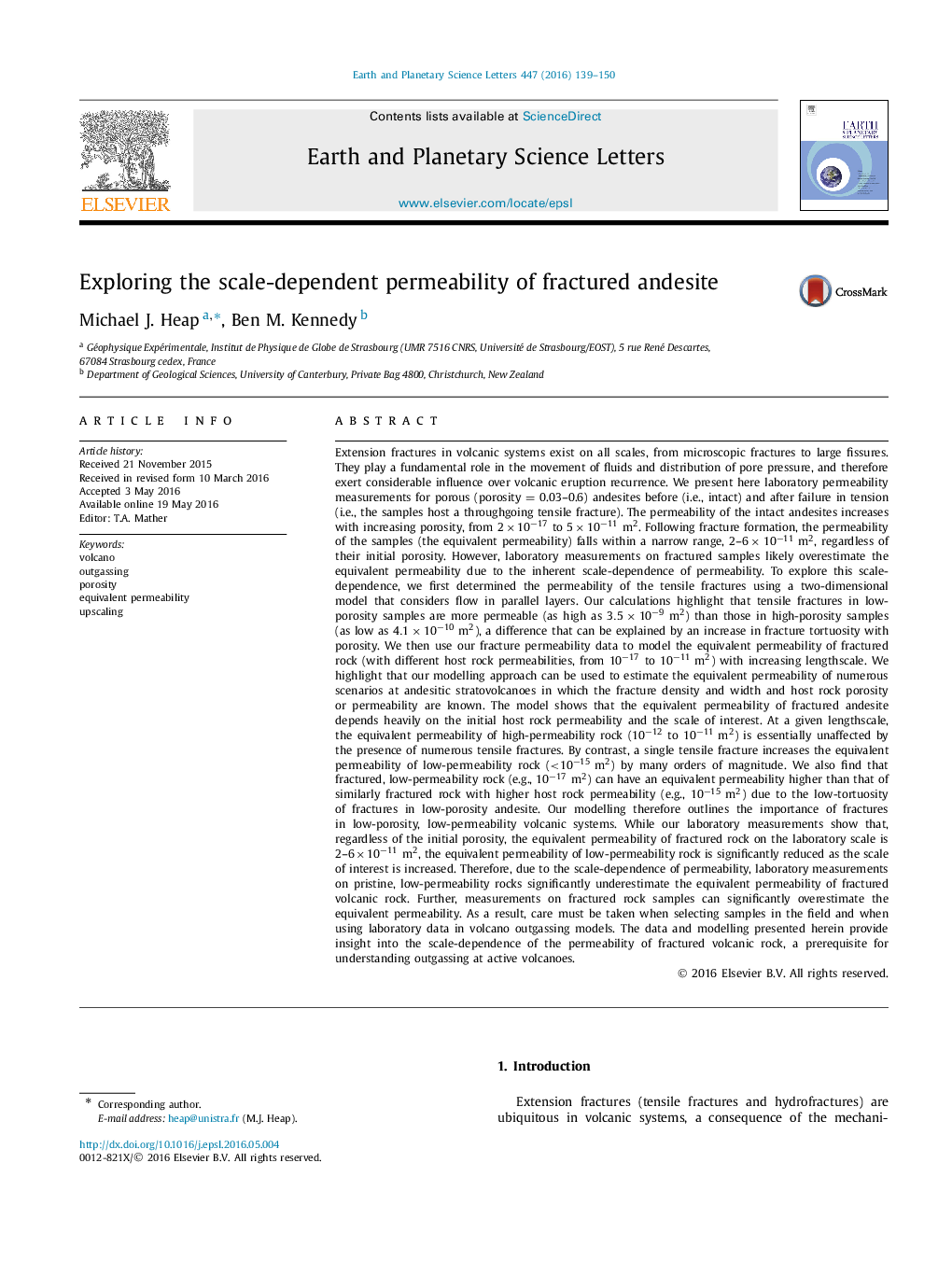| کد مقاله | کد نشریه | سال انتشار | مقاله انگلیسی | نسخه تمام متن |
|---|---|---|---|---|
| 6427476 | 1634709 | 2016 | 12 صفحه PDF | دانلود رایگان |
- Equivalent permeability of fractured samples falls within narrow range, regardless of porosity.
- Fracture permeability depends on fracture tortuosity, which is a function of the initial porosity.
- Equivalent permeability is modelled at different scales of interest using a simple model.
- Equivalent permeability of fractured rock depends heavily on initial host rock permeability and scale of interest.
Extension fractures in volcanic systems exist on all scales, from microscopic fractures to large fissures. They play a fundamental role in the movement of fluids and distribution of pore pressure, and therefore exert considerable influence over volcanic eruption recurrence. We present here laboratory permeability measurements for porous (porosity = 0.03-0.6) andesites before (i.e., intact) and after failure in tension (i.e., the samples host a throughgoing tensile fracture). The permeability of the intact andesites increases with increasing porosity, from 2Ã10â17 to 5Ã10â11Â m2. Following fracture formation, the permeability of the samples (the equivalent permeability) falls within a narrow range, 2-6Ã10â11Â m2, regardless of their initial porosity. However, laboratory measurements on fractured samples likely overestimate the equivalent permeability due to the inherent scale-dependence of permeability. To explore this scale-dependence, we first determined the permeability of the tensile fractures using a two-dimensional model that considers flow in parallel layers. Our calculations highlight that tensile fractures in low-porosity samples are more permeable (as high as 3.5Ã10â9Â m2) than those in high-porosity samples (as low as 4.1Ã10â10Â m2), a difference that can be explained by an increase in fracture tortuosity with porosity. We then use our fracture permeability data to model the equivalent permeability of fractured rock (with different host rock permeabilities, from 10â17 to 10â11Â m2) with increasing lengthscale. We highlight that our modelling approach can be used to estimate the equivalent permeability of numerous scenarios at andesitic stratovolcanoes in which the fracture density and width and host rock porosity or permeability are known. The model shows that the equivalent permeability of fractured andesite depends heavily on the initial host rock permeability and the scale of interest. At a given lengthscale, the equivalent permeability of high-permeability rock (10â12 to 10â11Â m2) is essentially unaffected by the presence of numerous tensile fractures. By contrast, a single tensile fracture increases the equivalent permeability of low-permeability rock (<10â15Â m2) by many orders of magnitude. We also find that fractured, low-permeability rock (e.g., 10â17Â m2) can have an equivalent permeability higher than that of similarly fractured rock with higher host rock permeability (e.g., 10â15Â m2) due to the low-tortuosity of fractures in low-porosity andesite. Our modelling therefore outlines the importance of fractures in low-porosity, low-permeability volcanic systems. While our laboratory measurements show that, regardless of the initial porosity, the equivalent permeability of fractured rock on the laboratory scale is 2-6Ã10â11Â m2, the equivalent permeability of low-permeability rock is significantly reduced as the scale of interest is increased. Therefore, due to the scale-dependence of permeability, laboratory measurements on pristine, low-permeability rocks significantly underestimate the equivalent permeability of fractured volcanic rock. Further, measurements on fractured rock samples can significantly overestimate the equivalent permeability. As a result, care must be taken when selecting samples in the field and when using laboratory data in volcano outgassing models. The data and modelling presented herein provide insight into the scale-dependence of the permeability of fractured volcanic rock, a prerequisite for understanding outgassing at active volcanoes.
Journal: Earth and Planetary Science Letters - Volume 447, 1 August 2016, Pages 139-150
